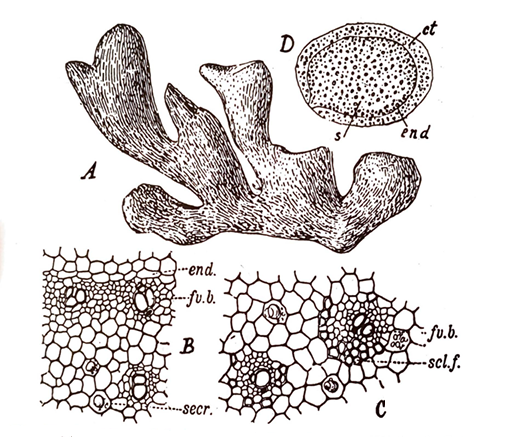Synonyms:
Zingiber, Rhizoma Zingiberis
Botanical source:
Ginger consists of the dried rhizomes of cultivated Zingiber officinale Roscoe devoid of their dark outer skin. The plant is a perennial herb of the family Zingiberaceae.
Geographical source:
Ginger plant is indigenous to Southeastern Asia and is cultivated in many tropical countries, notably in Jamaica (the official drug), Bangladesh, India, Nigeria and many other tropical countries.
Macroscopical characters:
The drug is a laterally compressed horizontal rhizome bearing short, obovate, oblique and somewhat flat branches, each branch exhibiting a depressed stem scar at the apex. It is 7 to 15 cm long, 3 to 6 cm wide and 0.5 to 1.5 cm thick. The surface has longitudinal striations with occasional projecting fibres and is buff or yellowish white in colour. The fracture is short and somewhat fibrous with a mealy fractured surface. The transversely cut surface shows a narrow cortex, a well-marked endodermis, a wide stele, numerous fibrovascular bundles and secretion cells. The drug has an aromatic odour and a pungent taste.
Microscopial characters:
No cork tissue is present in the whole or powdered drug. The cortical t6issue consists of thin-walled parenchyma cells with intercellular spaces. It also contains oleoresin cells and fibrovascular bundles. The endodermis is composed of tangentially elongated cells with suberised walls.
Below the endodermis is a ring of vascular bundles, which consist of phloem and reticulate non-lignified vessels. The remainder of the stele area consists of thin-walled large parenchymatous cells ‘ containing oil cells and scattered vascular bundles. A large number of starch grains is present in the parenchymatous cells. The starch grains are striated and ovate to sub-rectangular in shape with a hilum on the terminal projection. The powdered drug is yellowish buff in colour.
 Fig. 60: Ginger. A, whole drug; B, t.s. in the region of the endodermis; C, t.s. of the central part; D, transversely cut surface of the rhizome ct cortex· end endodermis; fv, b., fibrovascular bundle; s, stele; scf, f., sclerenchymatous fibres; seer., secretion cell. (Reconstructed from Wallis).
Fig. 60: Ginger. A, whole drug; B, t.s. in the region of the endodermis; C, t.s. of the central part; D, transversely cut surface of the rhizome ct cortex· end endodermis; fv, b., fibrovascular bundle; s, stele; scf, f., sclerenchymatous fibres; seer., secretion cell. (Reconstructed from Wallis).

Chemical constituents:
Ginger contains 5 to 8% resinous substances, the chief constituent of which is gingerol. Ginger also contains 0.25 to 3.0% volatile oil, which contains zingiberene, Citral, borneol. camphene and phellandrene. It also contains 50% starch, 2 to 3 % proteins and a small amount of sugar.
Uses:
Ginger is used as a carminative and aromatic stimulant. It is also used as a condiment
Substitutes and adulterants:
African Ginger, Bengal Ginger and· Cochin Ginger are varieties of the official Zingiber officinale Roscoe, which are used as its substitute. Japanese Ginger (Zingiber mioga), unscrapped Ginger, spent or exhausted ginger and wormy Ginger are frequently used to adulterate official Ginger.

